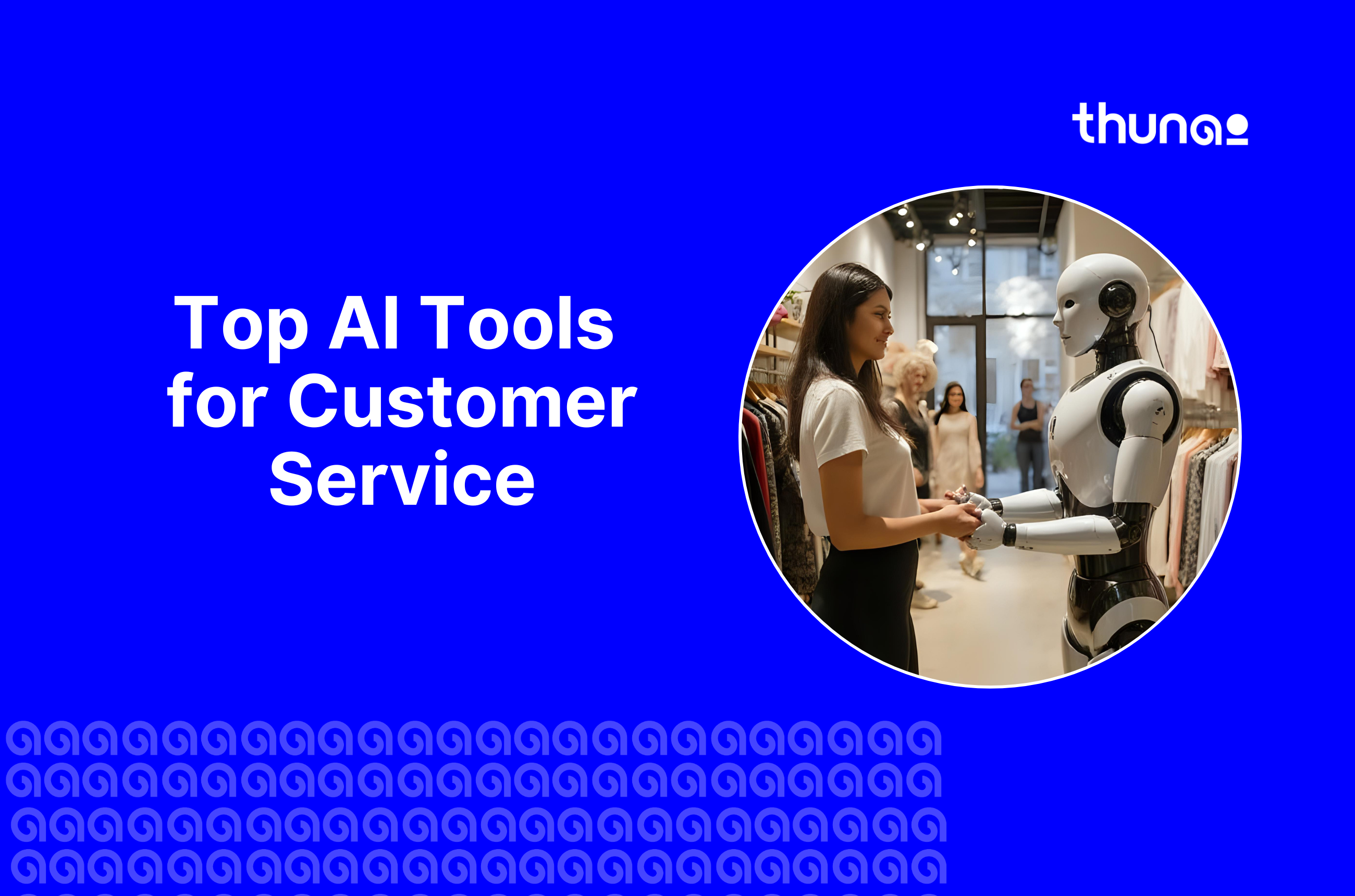How to Use Sentiment Analysis to Improve Customer Experience

.png)

Thunai learns, listens, communicates, and automates workflows for your revenue generation team - Sales, Marketing and Customer Success.
Do you have loads of reviews, support tickets, and social media posts? Is it hard to figure out your customers' true opinions from all that unstructured data?
Manually going through this feedback just won't work for most modern businesses.
That's why AI-powered customer sentiment analysis becomes a powerful tool for making sense of this information across your business, and here's how...
What is AI Customer Sentiment Analysis?
AI-powered customer sentiment analysis is an automated process that lleans on Natural Language Processing (NLP) and machine learning. The goal is to figure out how a customer feels about your brand, product, or service.
AI sentiment analysis looks at digital text and written-down speech then find out if the emotional tone is positive, negative, or neutral.
Modern customer sentiment analysis AI does more than hand out a simple positive or negative score. Infact, they aim to get at the type of the emotion your customer is feeling.
For instance, they can tell the difference between customer frustration (which may need a fast solution) and disappointment (which may call for an apology).
This AI analysis on customer sentiment can pull from many different data sources creating complete view of the customer, including:
- Social Media Platforms: Keeping track of mentions and comments on sites like Reddit and Twitter.
- Review Websites: Gathering up feedback from dedicated product and service review sites.
- Customer Support Channels: Looking over emails, support tickets, recorded voice calls and live chat transcripts.
- Direct Feedback: Working through data from surveys like Net Promoter Score (NPS) and CSAT.
4 Benefits of Customer Sentiment Analysis Using AI
1. Provide Proactive and Personalized Customer Support
AI sentiment analysis changes customer service from reactive to proactive. AI Customer support tools can automatically look at incoming support requests from emails and chats.
They bump up those with strongly negative feelings for urgent attention. This allows teams to spot and deal with important issues before they blow up.
AI sentiment analysis also opens the door for hyper-personalization. In fact, 76% of customers expect brands to pick up on and reflect their emotional tone in responses. This helps in:
- Automatically pointing out frustrated customers for escalation to a human agent.
- Giving agents the customer's emotional context to change their tone.
- Boosting customer satisfaction and building up stronger brand loyalty.
2. Manage Brand Reputation and Cut Down on Crises in Real Time
In an age of viral social media, a brand's reputation can be hurt in minutes. AI sentiment analysis acts as an important early warning system. It keeps track of online conversations in real-time.
By keeping an eye on customer sentiment analysis, teams can spot potential problems and deal with them quickly.
A sudden jump in negative mentions can alert a company to a product problem or a failing campaign. This lets them step in and fix things right away.
3. Guide Product Development with Detailed Feedback
Customer feedback is a goldmine for coming up with new product ideas and long-term planning. Customer sentiment analysis tools give you a way to go through all this information, even when you have tons of it.
A really helpful technique is called Aspect-Based Sentiment Analysis (ABSA). This method zeroes in on specific parts of a product or service.
For example, a smartphone maker could use ABSA to find out that customers feel good about the camera but really bad about the battery life. This allows engineers to focus on what matters most.
4. Improve Key Business Metrics like Churn and Retention
The impact customer sentiment analysis on churn and retention is real and you can measure it. This isn't just made-up theory. Industry data shows that businesses that follow through on these customer sentiment insights see bigger gains.
Effective customer sentiment analysis can result in up to a 15% increase in customer retention and a 21% decrease in customer churn. By spotting the early signs of bad results, companies can kick off proactive workflows that hold on to revenue and keep your customer base growing.
How to Get Started with Customer Sentiment Analysis Using AI
From a planning perspective, you should roll this out in phases:
- Phase 1: Monitor and Learn. Start by keeping an eye on public brand mentions to get a baseline and figure out public perception.
- Phase 2: Connect and Analyze. Hook up the AI to internal data (support tickets, surveys) for a single customer view and to dig up root causes.
- Phase 3: Automate and Intervene. Use real-time analysis in live chat or calls to kick off proactive steps, like bumping up a frustrated customer.
But despite all of this building you complete customer sentiment analysis framework from scratch doesn’t make sense - you’ll need to use a AI tool that allow you create this framework instantly….
Automating Customer Sentiment Analysis With Thunai
Stop letting the true opinions of your customers slip through the cracks in unstructured data. In the age of AI, manually going through every review and ticket just makes no sense.
Thunai can speed up how you make sense of customer feedback. This frees up your agents for tricky problem-solving that boosts CSAT. With Thunai's AI-based customer intelligence, you get:
- AI-Based Root Cause Analysis: Automatically analyze thousands of support tickets, surveys, and call transcripts to identify the why behind your customer sentiment. Stop guessing and dig up the root cause of positive and negative trends.
- Real-Time Sentiment Alerts: Get instant notifications for big jumps in negative sentiment. Allow your support and PR teams to deal with a crisis before it blows up, protecting your brand reputation.
- Thunai Brain for CX: One spot for all your customer insights. Give your product, marketing, and support teams with a single dashboard of customer sentiment. This system keeps track of key topics and product features, all from a single knowledge source.
- Proactive Support Workflows: Automatically tag and route conversations based on detected sentiment. Make sure frustrated or angry customers are immediately passed on to the right team for resolution.
Ready to see your customer retention and CSAT metrics go up? Try Thunai for free and turn your customer feedback into smart actions!
5 Real-World Examples of Customer Sentiment Analysis in Big Companies
The value of sentiment analysis is shown when top brands use it to get real results.
- Nike (Brand Management): During its controversial Colin Kaepernick ad campaign, Nike used real-time sentiment analysis to keep track of millions of social mentions. The system helped them tell the difference between initial outrage (which was noise) and long-term brand loyalty (which was the signal). By staying on top of the conversation, Nike ultimately saw a $6 billion increase in brand value.
- Zappos (Churn Decrease): Zappos looked at its support channel text. They found out that customers using certain negative phrases were 80% more likely to send back products. They set up a workflow to flag these conversations for their most experienced agents. This brought about a 15% drop in product return rates.
- Delta Airlines (Crisis Response): When a major IT outage caused delays, Delta's sentiment analysis showed customer frustration came from the lack of information more than the delay itself. This insight led to a shift to frequent, transparent updates. This brought down negative sentiment by 37% within 24 hours.
- Shopify (Support Effectiveness): The e-commerce platform automated its support ticket sorting using sentiment analysis. The system bumps up tickets with strongly negative sentiment and important keywords (e.g., phrases like store down). This cut down the average response time for important issues from 4.2 hours to just 27 minutes.
- TechSmith (Product Development): The software company used NLP to go over user feedback. They dug up a key insight: users were more fed up with the product's help guides than its UI. They redid their help materials. This led to a 32% decrease in negative mentions and an 18% increase in user upgrades.
Solving the Challenges of Customer Sentiment Analysis With Thunai
AI sentiment analysis runs into many challenges. Human language is tricky.
Correctly spotting sarcasm, figuring out context like the word 'sick,' and handling multiple languages are common problems.
So how do you get insights you can actually use?
That's where customer sentiment analysis tools like Thunai comes in. The platform is built specifically for these real-world challenges. Advanced models inside Thunai understand context and slang. At the same time, the AI-based root cause analysis gives you really accurate insights.
Ready to see your customer retention and CSAT metrics go up? Try Thunai for free and turn your customer feedback into smart actions!
FAQs on Customer Sentiment Analysis
What is the difference between customer sentiment analysis and emotion detection?
Customer sentiment analysis usually sorts an expression as positive, negative, or neutral. Emotion detection is more detailed. This method tries to find specific feelings like joy, anger, sadness, or frustration. Future systems are moving toward this deeper emotion detection to give you more useful insights.
What is Aspect-Based Sentiment Analysis (ABSA)?
ABSA is a technique that focuses on specific features or parts of a product or service. Instead of just saying a review is negative, this analysis can tell you the customer felt good about the camera but bad about the battery life. This is extremely helpful for product development.
What are the main business uses for customer sentiment analysis analysis?
The main uses are to turn customer feedback into action plans. This includes proactive customer support automation (by bumping up urgent tickets), real-time brand reputation and crisis management, and guiding product development by figuring out what customers love or hate about specific features.
How does AI handle sarcasm in text?
Sarcasm is a major challenge because positive words are used to show a negative meaning. Simple models fail by seeing only the positive words. Advanced deep learning models, like Transformers, look at the full context of a sentence. They can spot the mismatch between a word like great and a negative situation, like a package is lost. This helps them figure out the true sarcastic meaning.






